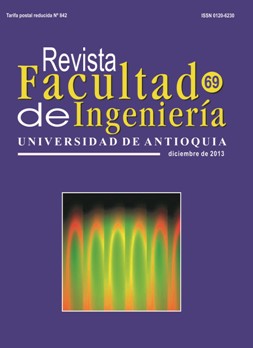Active Perturbation Rejection in Motion Control of Milling Machine Tools
DOI:
https://doi.org/10.17533/udea.redin.18149Keywords:
motion control, motion planning, perturbation rejection, milling machine toolAbstract
This article deals with the robust control problem of the motion axes of milling machine tools subjected to perturbation forces induced by the metal machining process. A position output feedback control scheme is proposed for robust rejection of unknown cutting and friction perturbation forces and robust tracking tasks of motion trajectories planned for a three-axis milling machine tool. The Coulomb friction, viscous damping and cutting forces are considered as terms of an unknown time-varying disturbance input signal affecting the dynamics of the motion axes of the milling machine. In the motion control design, the perturbation signal is modeled locally by a fourth degree Taylor time-polynomial family. Then, a state observer is designed to estimate the disturbance and velocity signals required for implementation of the proposed motion controllers. Simulation results are included to show the robust performance of the proposed motion control scheme and the fast and effective estimation of the perturbation and velocity signals.
Downloads
References
H. Ding, S. Chen, K. Cheng. “Two-Dimensional Vibration-Assisted Micro End Milling: Cutting Force Modelling and Machining Process Dynamics.” Proc. IMechE Part B: J. Engineering Manufacture. Vol. 224. 2010. pp. 1775-1783. DOI: https://doi.org/10.1243/09544054JEM1984
M. Kaymakci, Z. Kilic, Y. Altintas. “Unified Cutting Force Model for Turning, Boring, Drilling and Milling Operations.” International Journal of Machine Tools & Manufacture. Vol. 54-55. 2012. pp. 34-45. DOI: https://doi.org/10.1016/j.ijmachtools.2011.12.008
X. Jin, Y. Altintas. “Prediction of Micro-Milling Forces with Finite Element Method.” Journal of Materials Processing Technology. Vol. 212. 2012. pp. 542-552. DOI: https://doi.org/10.1016/j.jmatprotec.2011.05.020
T. Schmitz, K. Smith. “Machining Dynamics - Frequency Response to Improved Productivity.” Ed. Springer. 2009. pp. 99-170.
K. Ehmann, S. Kapoor, R. Devor, I. Lazoglu. “Machining Process Modeling: A Review.” Journal of Manufacturing Science and Engineering. Vol. 119. 1997. pp. 655-663. DOI: https://doi.org/10.1115/1.2836805
R. DeVor, W. Kline, W. Zdeblick. A Mechanistic Model for the Force System in End Milling with Application to Machining Airframe Structures. Proceedings of the 8th North American Conference on Metalworking Research. Rolla, USA. 1980. pp. 297-303.
W. Kline, R. DeVor, J. Lindberg. “The Prediction of Cutting Forces in End Milling with Application to Cornering Cuts.” International Journal of Machine Tool Design and Research. Vol. 22. 1982. pp. 7-22. DOI: https://doi.org/10.1016/0020-7357(82)90016-6
D. Stephenson, J. Agapiou. Metal Cutting Theory and Practice. 2th ed. Ed.Taylor & Francis. Boca Raton, USA. 2006. pp. 459-502.
J. Lee, W. Dixon, J. Ziegert. “Adaptive Nonlinear Contour Coupling Control for a Machine Tool System.” The International Journal of Advanced Manufacturing Technology. Vol. 61. 2012. pp. 1057-1065. DOI: https://doi.org/10.1007/s00170-011-3760-1
J. Fortgang, W. Singhose, J. Márquez, J. Perez. “Command Shaping Control for Micro-milling Operations.” International Journal of Control, Automation, and Systems. Vol. 9. 2011. pp. 1136-1145. DOI: https://doi.org/10.1007/s12555-011-0615-3
K. Byung, R. Seung, P. Jong. “Development of a 3-axis Desktop Milling Machine and a CNC System Using Advanced Modern Control Algorithms.” International Journal of Precision Engineering and Manufacturing. Vol. 11. 2012. pp. 39-47. DOI: https://doi.org/10.1007/s12541-010-0005-4
B. Yao, M. Al, M. Tomizuka. “High-Performance Robust Motion Control of Machine Tools: An Adaptive Robust Control Approach and Comparative Experiments.” IEEE/ASME Transactions on Mechatronics. Vol. 2. 1997. pp. 63-76. DOI: https://doi.org/10.1109/3516.588624
Y. Koren. “Control of Machine Tools.” Journal of Manufacturing Science and Engineering. Vol. 119. 1997. pp. 749-755. DOI: https://doi.org/10.1115/1.2836820
T. Zheng, Y. Syh, H. Pau. The Integrated Linear and Nonlinear Motion Control Design for Precise CNC Machine Tools. Proceedings of the 2004 IEEE International Conference on Control Applications. Taipei, Taiwan. 2004. pp. 724-729.
J. Zheng, M. Zhang, K. Meng. Modeling and Design Servo System of CNC Machine Tools. Proceedings of the 2006 IEEE International Conference on Mechatronics and Automation. Luoyang, China. 2006. pp. 1964-1969. DOI: https://doi.org/10.1109/ICMA.2006.257555
H. Sira, V. Feliu, F. Beltran, A. Blanco. SigmaDelta Modulation Sliding Mode Observers for Linear Systems Subject to Locally Unstable Inputs. Proceedings of the 16th Mediterranean Conference on Control and Automation. Ajaccio, France. 2008. pp. 344-349.
M. Fliess, R. Márquez, E. Delaleau, H. Sira. “Correcteurs Proportionnels-Intégraux Generalisées.” ESAIM, Control, Optimization and Calculus of Variations. Vol. 7. 2002. pp. 23-41. DOI: https://doi.org/10.1051/cocv:2002002
E. Chávez, F. Beltrán, A. Valderrábano, A. Favela. “Active Vibration Control of Vehicle Suspension Systems Using Sliding Modes, Differential Flatness and Generalized Proportional-Integral Control.” Rev. Fac. Ing. Univ. Antioquia. No. 61. 2011. pp. 104-113.
Downloads
Published
How to Cite
Issue
Section
License
Copyright (c) 2018 Revista Facultad de Ingeniería

This work is licensed under a Creative Commons Attribution-NonCommercial-ShareAlike 4.0 International License.
Revista Facultad de Ingeniería, Universidad de Antioquia is licensed under the Creative Commons Attribution BY-NC-SA 4.0 license. https://creativecommons.org/licenses/by-nc-sa/4.0/deed.en
You are free to:
Share — copy and redistribute the material in any medium or format
Adapt — remix, transform, and build upon the material
Under the following terms:
Attribution — You must give appropriate credit, provide a link to the license, and indicate if changes were made. You may do so in any reasonable manner, but not in any way that suggests the licensor endorses you or your use.
NonCommercial — You may not use the material for commercial purposes.
ShareAlike — If you remix, transform, or build upon the material, you must distribute your contributions under the same license as the original.
The material published in the journal can be distributed, copied and exhibited by third parties if the respective credits are given to the journal. No commercial benefit can be obtained and derivative works must be under the same license terms as the original work.










 Twitter
Twitter